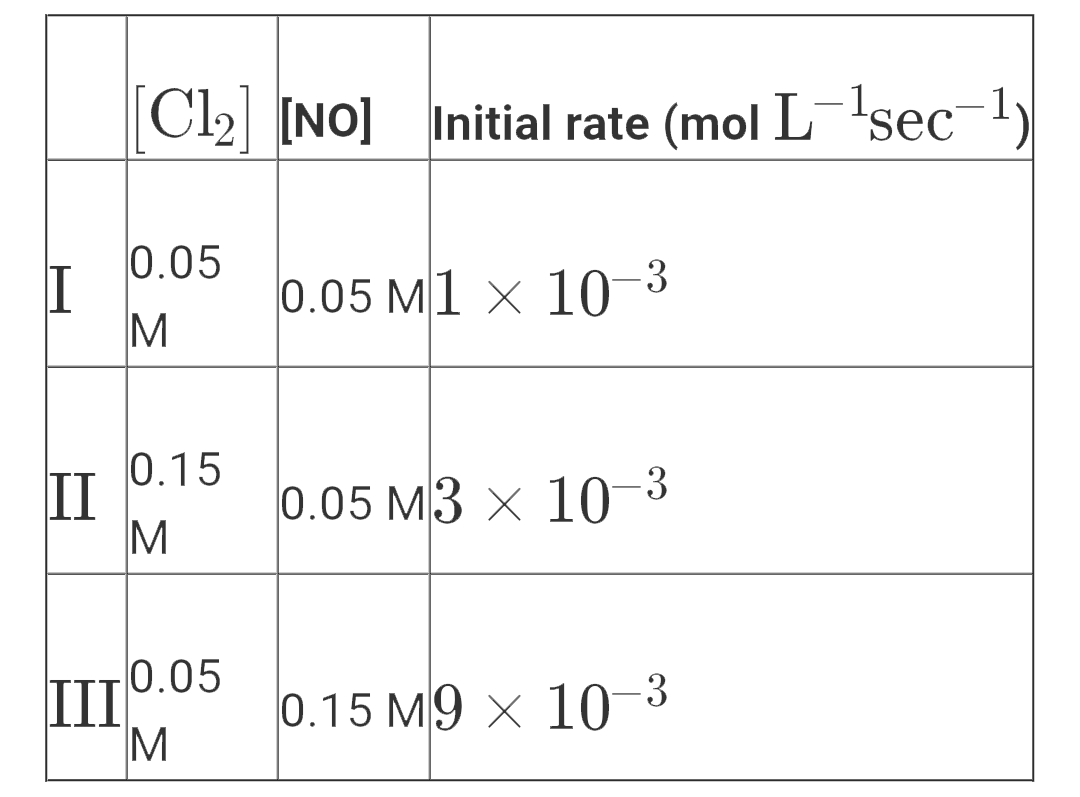Consider the reaction
2NO(g)+O2(g)→2NO2(g), Predict whether the reaction is spontaneous at 298 K. ΔfG(NO)=86.69kJ/mol,ΔfG(NO2=51.84kJ/mol
Yes , Spontaneous
No, the reaction is Non-spontaneous
Equilibrium
Cannot predict
To determine whether the reaction 2NO(g)+O2(g)→2NO2(g) is spontaneous at 298 K, we will calculate the change in Gibbs free energy (ΔG) for the reaction using the given standard Gibbs free energies of formation (ΔfG) for the reactants and products.
1. Identify the Gibbs Free Energy of Formation Values:
- ΔfG(NO)=86.69kJ/mol
- ΔfG(NO2)=51.84kJ/mol
2. Write the Expression for ΔG of the Reaction:
The change in Gibbs free energy (ΔG) for the reaction can be calculated using the formula:
ΔG=ΔGproducts−ΔGreactants
3. Calculate ΔG for the Products:
Since there are 2 moles of NO2 produced:
ΔGproducts=2×ΔfG(NO2)=2×51.84kJ/mol=103.68kJ
4. Calculate ΔG for the Reactants:
Since there are 2 moles of NO and 1 mole of O2 (note that ΔfG(O2)=0kJ/mol because it is in its standard state):
ΔGreactants=2×ΔfG(NO)+1×ΔfG(O2)=2×86.69kJ/mol+0=173.38kJ
5. Calculate ΔG for the Reaction:
Now substitute the values into the ΔG equation:
ΔG=103.68kJ−173.38kJ=−69.70kJ
6. Determine Spontaneity:
A reaction is spontaneous if ΔG<0. Since we calculated ΔG=−69.70kJ, which is negative, the reaction is spontaneous.
Conclusion:
The reaction 2NO(g)+O2(g)→2NO2(g) is spontaneous at 298 K.
- ΔfG(NO)=86.69kJ/mol
- ΔfG(NO2)=51.84kJ/mol
The change in Gibbs free energy (ΔG) for the reaction can be calculated using the formula:
ΔG=ΔGproducts−ΔGreactants
Since there are 2 moles of NO2 produced:
ΔGproducts=2×ΔfG(NO2)=2×51.84kJ/mol=103.68kJ
Since there are 2 moles of NO and 1 mole of O2 (note that ΔfG(O2)=0kJ/mol because it is in its standard state):
ΔGreactants=2×ΔfG(NO)+1×ΔfG(O2)=2×86.69kJ/mol+0=173.38kJ
Now substitute the values into the ΔG equation:
ΔG=103.68kJ−173.38kJ=−69.70kJ
A reaction is spontaneous if ΔG<0. Since we calculated ΔG=−69.70kJ, which is negative, the reaction is spontaneous.
The reaction 2NO(g)+O2(g)→2NO2(g) is spontaneous at 298 K.
Similar Questions
At 298K,Kp for reaction N2O4(g)⇔2NO2(g) is 0.98. Predict whether the reaction is spontaneous or not.
View SolutionConsider the reaction:
2NO(g)+O2(g)→2NO2(g)
Calculated the standard Gibbs energy change at 298K and predict whether the reaction is spontaneous or not. ΔfGΘ(NO)=86.69kJmol−1,ΔfGΘ(NO2)=51.84kJmol−1.
View Solution
Knowledge Check
Consider the following reaction :
CO(g)+12O2(g)→CO2(g)
How are ΔU and ΔH related for the reaction ?A(a) ΔH=ΔU−0.5RTB(b) ΔH=ΔU−RTC(c) ΔH=ΔU+0.5RTD(d) ΔH=ΔU−1.5RT
Consider the reaction:
2NO(g)+O2(g)→2NO2(g)
Calculated the standard Gibbs energy change at 298K and predict whther the rection is spontaneous or not. ΔfGΘ(NO)=86.69kJmol−1,ΔfGΘ(NO2)=51.84kJmol−1.
View SolutionConsider the reaction:
4NH3(g)+5O2(g)→4NO(g)+6H2O(l)ΔGΘ=−1010.5kJ
Calculate ΔfGΘ[NO(g)]ifΔfGΘ(NH3)=−16.6kJmol−1 and ΔfGΘ[H2O(l)]=−237.2kJmol−1.
View SolutionThe given data are for the reaction, 2NO(g)+Cl(g)→2NOCl(g) at 298K

The rate law of the reactions is
View SolutionWill the reaction,
I2(s)+H2S(g)→2HI(g)+S(s)
proceed spontaneously in the forward direction of 298K
ΔfGΘHI(g)=1.8kJmol−1,ΔfGΘH2S(g)=33.8kJmol−1?
View SolutionCalculate equilibrium constant for the reaction:
2SO2(g)+O2(g)⇔2SO3(g)at25∘C
Given: ΔfGΘSO3(g)=−371.1kJmol−1,
ΔfGΘSO2(g)=−300.2kJmol−1
and R=8.31JK−1mol−1
View SolutionFor the reaction, A(g)+B2(g)→AB2(g),δS=110JK−1mol−1,δH=55kgmol. Reaction will be spontaneous at
View SolutionThe resting of iron occurs as:
4Fe(s)+3O2(g)→2Fe2O3(s)
The entalpy of formation of Fe2O3(s)is−824.0kJmol−1 and entropy change for the reaction is +550JK−1mol−1. Calculate ΔsurrS and predict whether resuting of iron is spontaneous or not at 298K.
Given ΔsysH=−553.0JK−1mol−1
View Solution
